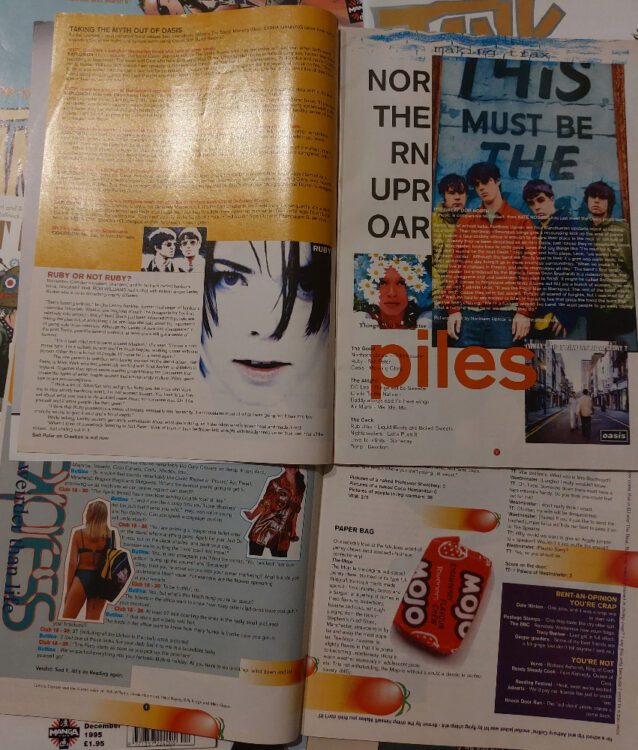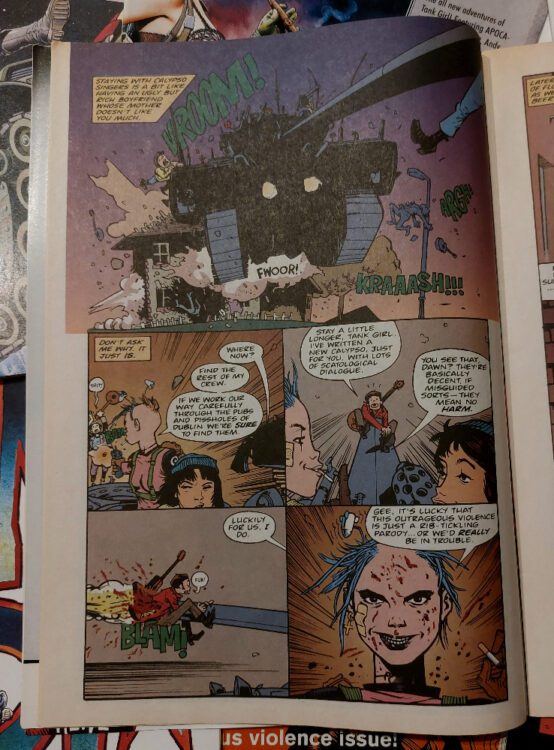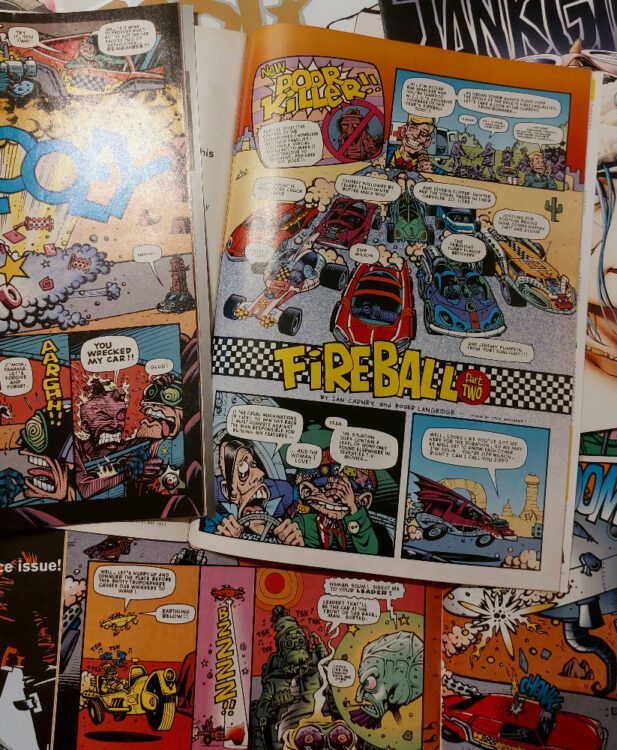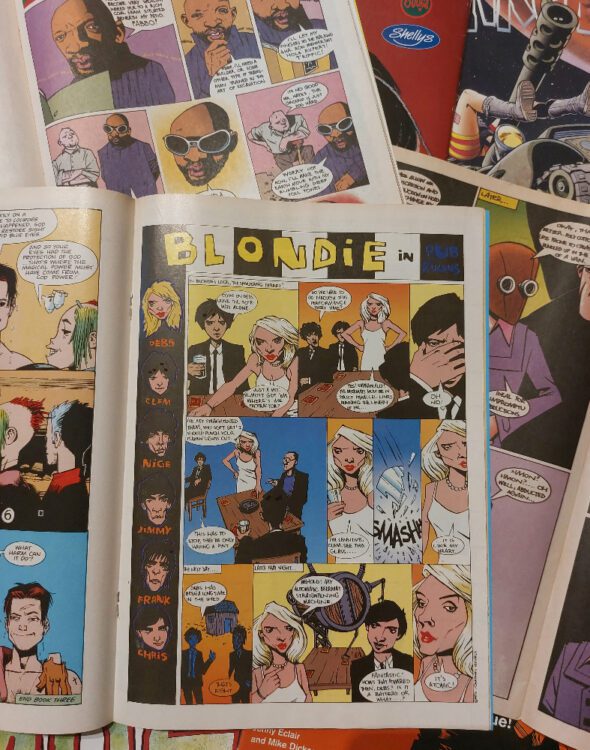The premise is simple: read one comic every day for the entire year. It seems like a simple task but there is no way that I read 365 comics last year, even if you count the individual issues in collections. So, this year, I am committing myself to this reading challenge, in the hope that I can broaden my reading habits and fully engage with my favorite hobby again.
After the last couple of intensive weeks of reading, writing, and research, I wanted a nice, easy read for this week. A sort of palette cleanser, as it were. Also, something that would help me catch up on the writing side of this project, because I’ve started to slip behind. So, I picked up Manga Publishing Ltd’s eight-issue 1995 UK magazine Tank Girl.
Eight issues of comic and music mayhem with the ultra-violent, post-feminist icon at the lead: easy reading, right?

Tank Girl has a long history dating back to 1988, and first appeared in the UK comics magazine Deadline. From the very beginning, the creation by Alan Martin and Jamie Hewlett had strong ties with UK music journalism and popular culture as a whole. The comic strip lambasted British television celebrities, politicians, and anyone who might be recognizable to savvy readers. The content of those early strips was violent, sexual, crude, and — most of all — anarchic. Tank Girl was punk rock in comic form. There is no coincidence that the image of Tank Girl riding around in her favorite armored vehicle appeared less than two years after the British Prime minister Margaret Thatcher was photographed in a tank. The tone of the comic strip was a clear reaction to the conservative politics of the time. Unlike the PM, Tank Girl appealed to the disenchanted youth of the country, anarchists, and creative freethinkers.
From day one, Tank Girl and her creators had something to say about politics, religion, pop culture, and graphic storytelling.
Unfortunately, the Tank Girl movie seemed to end the growing popularity of the character, and the comic fell by the wayside until 2007 (also Hewlett wandered off to create Gorillaz with Damon Albarn).
The Manga Publishing Tank Girl title started in 1995 and ran until January 1996. Not a long run, but it did produce a wonderful mix of indie music journalism, lad mag style articles, and absurdist comics. The Tank Girl main strip were reprints of the DC Vertigo title Tank Girl: The Odyssey and Tank Girl: Apocalypse, and were joined by the regular back-up strip Fireball by Ian Carney, Roger Langridge, and Steve Whitaker (based on an earlier Hewlett strip for Deadline magazine). Additional comic extras were in the form of Milk and Cheese (dairy products gone bad), extra Tank Girl by a collection of writers and artist, and a one-page musical gag by Jonathan ‘insert funny name here’ Edwards. These one pagers still make me laugh and groan in equal measure.

The magazine was of its time, at least as far as the text elements go. Underhand insults barely disguised as jokes featured in the Tomato Express opening pages, and any excuse to mention sex and drugs seemed to be the impetus behind most of the other sections. Although, the band interviews and small album/single reviews do seem to explain a lot about my burgeoning taste in the mid 1990s. Many of the band names have probably been forgotten by most people in the UK, and I doubt they made it across the big pond, however, I still listen to the likes of Ruby, Inspiral Carpets, and Red Snapper.
I’m not sure the jokes about Jimmy Savile and the questionnaire to see if you would make a good Michael Jackson would play as well in today’s market. But pushing the boundaries was the name of the game, and this magazine definitely did this back in 1995.
The central element of the magazine was, obviously, the Tank Girl comic strips, especially The Odyssey and Apocalypse. The Odyssey was written by Peter Milligan and illustrated by Jamie Hewlett. The comic was a superb melding of classical literature, the modern novel, and post-feminist grandstanding. It is “structured by manipulating a continuous parallel between contemporaneity and antiquity,” explains Thomas A Vogler in his essay James Joyce Meets Tank Girl for the European Joyce Studies (Vol 15) in 2003. He goes on to comment on the script, noting that it contains “levels of diction that exhibit a Joycean range, from the esoteric, archaic, and polysyllabic […] to the scatological and obscene.” This is because Milligan has a firm grasp on the influences for the story — James Joyce’s Ulysses and Homer’s Odyssey — as well as the original comic strips written by Alan Martin. He is not afraid to mix the highbrow and the lowbrow, demanding the reader is proficient in both worlds to understand the references.

Vogler says that the story is a push back against media exploitation, something that he infers is damaging the comics purity after the release of the 1995 film adaptation. However, I think that he has under-sold the movie and is quick to dismiss it. The Tank Girl movie was not a financial success and does contain some questionable elements, however, it reached the audience it was aimed at and has become something of a cult classic. Rachel Talalay directed a sincere movie that pulled out the heart of the Tank Girl comic strips, while playing down some of the more excessive elements. And Lori Petty was perfectly cast as the lead.
The Odyssey creates a narrative world for Tank Girl to exist in, while maintaining the absurdist elements of the original 1980s strips. The blatant post-feminist views expressed in earlier strips is also a major part of Milligan’s narrative with the central character flaunting her freedoms and not allowing gendered stereotypes dictate her actions. She embraces both masculine and feminine traits, ideologies, and actions.

The clever witticisms and pop culture satire that makes the often vulgar Tank Girl strip so appealing, even today, isn’t reflected as well in the back-up strip Fireball. Carney and Langridge’s Cannonball-esq death race of a comic is, on occasions, a car crash of a comedy. Jokes that may have appealed nearly 30 years ago are awkward in a re-read, and some were even uncomfortable at the time. The artwork captures the adult Wacky Races feel that the narrative is aiming for, but a number of the gags don’t land, and the final part rolls to an unsatisfactory end despite the explosive finale. There are sections of the comic worth reading, and it’s not the groaning mess of some of the text sections in the magazine, but it hasn’t stood the test of time like the Tank Girl stories.
Special note, at this point, should go to Jonathan ‘It’s about time I got another mention’ Edwards. His one-page music gag strips and, in the final two issues, the flawed secret service agent comic Simon Creem are excellent little comics that bring joy to the world. Edwards is able to turn a groaning dad joke into a clever play on words mixed with musical references and wonderfully angular artwork, His caricatures are instantly recognizable while still being uniquely his own style. The magazine would have benefited from the inclusion of more of his work.

All in all, I have enjoyed this trip down memory lane, discovering where some of my musical influences came from, and getting my fingers grubby on a Tank Girl comic strip. I think that covers off comics 217 to 223, with one left over as a spare.

